The story of Raków Częstochowa is one of lamentable lows and euphoric heights. In 1994, the minnows reached the top flight of Polish football, battling it out with the best in the country for a period of four years.
Unfortunately, a horrific period of three years saw the club plunge down to the fifth division. It looked as though a return to the top of the pyramid was nothing more than a dreary dream that fell outside the realm of possibility. But in football, nothing is impossible.
In 2016, whilst floating around the third tier, the board made the greatest decision in the club’s history and appointed Marek Papszun to the dugout at the Miejski Stadion Piłkarski. Three years later, promotion back to the Ekstraklasa was complete. Raków were back.
Fast forward another two years to 2021, and the club lifted the first major trophy in its history, beating Arka Gdynia on penalties to win the Polish Cup. Raków also finished second that season in the league, the club’s highest-ever finish, qualifying them for the UEFA Europa conference league in its inaugural campaign.
Now, as of 2023, Raków are top of the Ekstraklasa, nine points clear of last season’s champions Legia Warszawa and are on course to win the league for the first time ever. From the fifth division to the best club in Poland, fairytales do happen. Nothing is outside the realm of possibility.
This tactical analysis piece will be a team scout report of Raków this season. It will be an analysis of Papszun’s tactics which have turned the Medaliki into champions-elect.
Preferred formations and statistical overview
Without even analysing any in-game footage, and merely looking at the data at hand from the pizza chart provided below, Raków’s style of play is very telling.
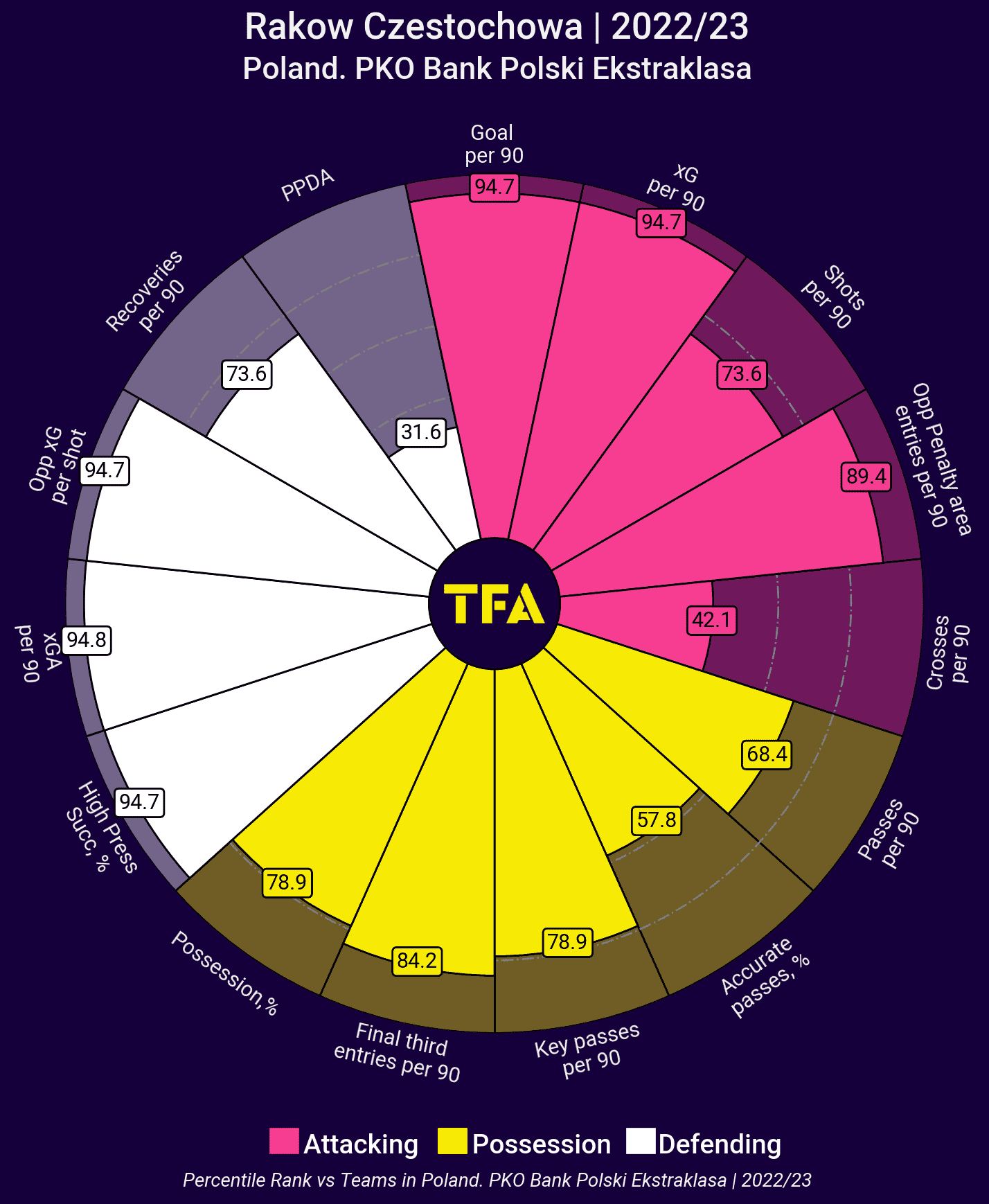
The head coach is clearly very keen for his players to be solid in the defensive phase, hence why Raków are the best team in the Ekstraklasa for xG against and xG against per shot.
The league leaders also press very high up the pitch which is why they rank quite low on Passes allowed Per Defensive Action (PPDA), which is a good thing, don’t worry! The lower the PPDA, the less a team allows their opponents to have possession of the ball. And they are really successful when they do press high, sitting comfortably in the 95th percentile.
What the pizza chart also tells us is that Papszun wants to have the ball, but it is not a necessity. This is evident from them only being in the 68th percentile for passes per 90. They have also averaged just around 50.4 percent of the ball in each game this season.
Raków are comfortable in possession and want to build their way through the thirds of the pitch on the deck but focus heavily on using crosses when in the final third.
You may not be surprised to hear that Raków have the highest number of goals scored in Poland’s top flight and the highest xG despite only being in the 77th percentile for shots on goal. the forwards are ruthless. Raków have the best defence and the best attack. It’s no surprise that they’re running away with the title.
But what about formations? Is Papszun tactically flexible regarding base formations, changing to suit the opponents at hand, or have the leaders stuck with what they’re good at?
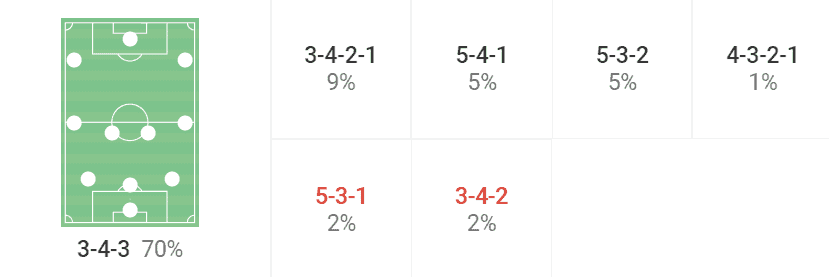
The 48-year-old has been quite mulish when it comes to formations. The 3-4-3 comes out on top by a country mile, with the team using the back-three structure, including its close cousins 3-4-2-1 and 5-4-1 in 84 percent of their games this season.
The 5-3-2 and 4-2-3-1 have also been trialled by the head coach but when a team are preparing to face Raków, it’s pretty certain that a 3-4-3 is awaiting them.
Nevertheless, it’s extremely important to note that formations are nothing but a way to quantify the positions of each player and to give them a rough guide of where to be on the pitch, particularly out of possession.
It is far more beneficial to analyse the team’s principles within the context of their formation choice. So, with that in mind, let’s take a look at Raków’s style of play in the framework of a 3-4-3 to see why they are the best side in the country.
Press like there’s no tomorrow
Raków are so intense when pressing high up the pitch. The team’s Passes allowed Per Defensive Action rate averages out at 7.85 which is the fourth-highest rate in the Ekstraklasa.
PPDA measures the number of passes an opponent makes before the defending team intervenes and so the lower the number, the higher a team presses. Essentially, in layman’s terms, Raków allow the attacking side to make roughly just under eight passes before engaging.
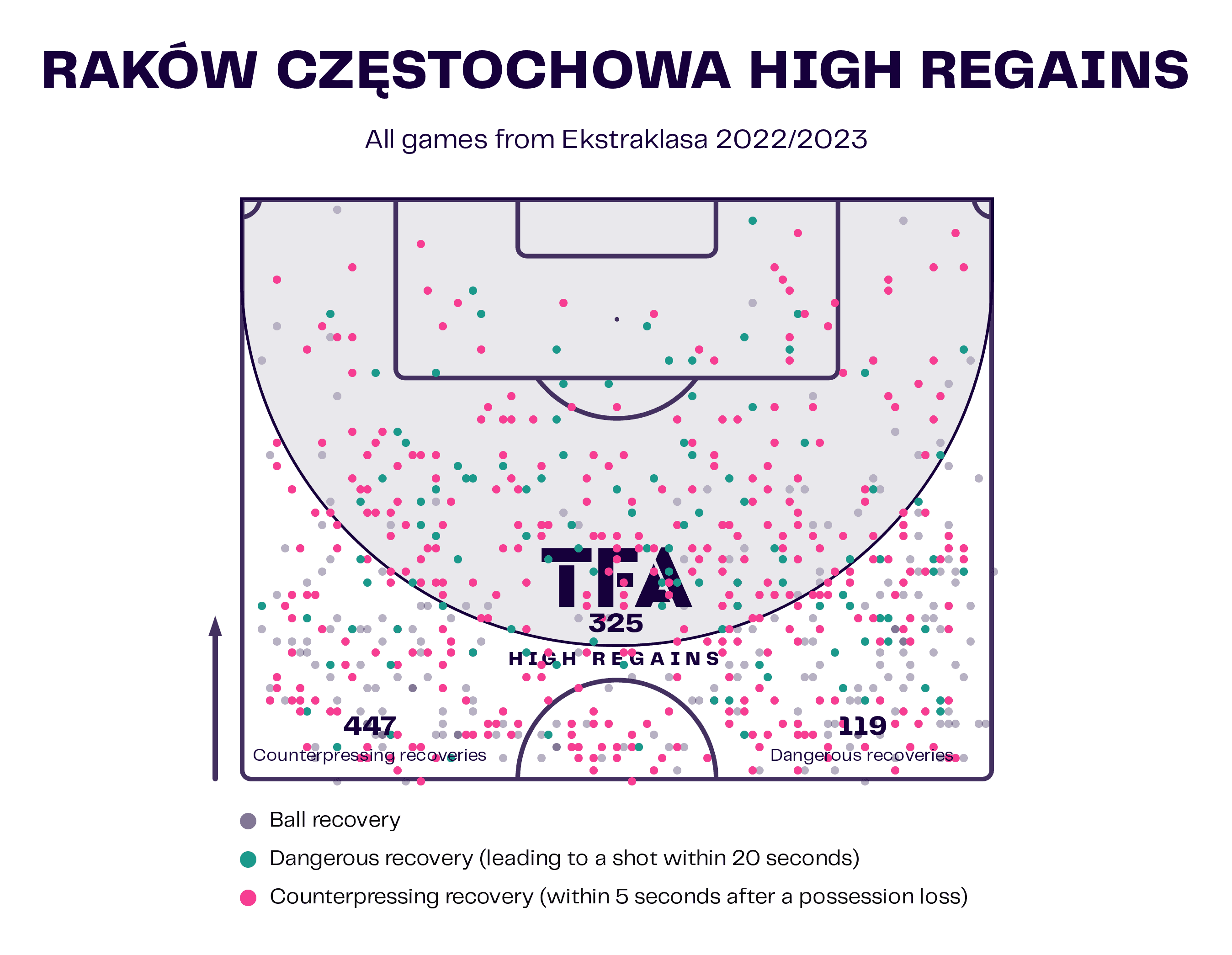
Raków’s high regains map tells us just how good they are in this phase too. 325 high regains in total alongside 447 counterpressing recoveries and 119 dangerous recoveries is an impressive showing from Papszun’s men.
Breaking this down even further, Raków has registered 30 of these regains in the opposition’s penalty area, including 11 dangerous recoveries which led to shots on goal and 18 counterpressing recoveries.
To be this successful while defending in the opposite half of the pitch, the league leaders would need to deploy a fairly high line when defending in a structured block…which they absolutely do.
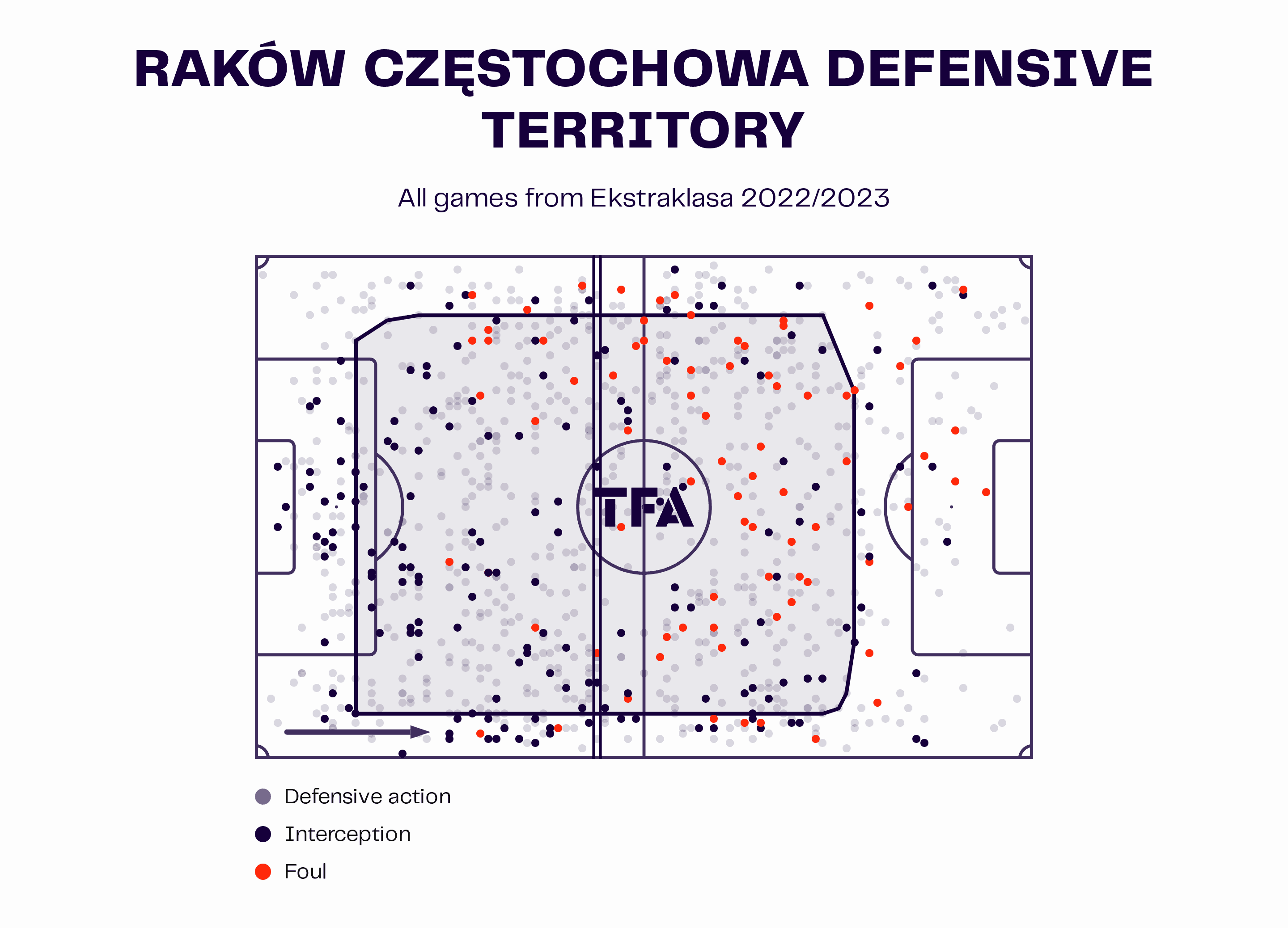
The Medaliki’s average defensive line height is right up at the halfway line which allows them to squeeze the pitch as much as possible to limit the space between the lines of the backline, midfield and attack at any given moment.
There are downsides to playing this way, of course, but more on this later. Nevertheless, it has been a revelation by Raków this season, for the most part.
They are so intense, so hungry to force you into mistakes. If you travel to the Miejski Stadion Piłkarski, you better bring your very best build-up game because you will be punished with absolutely zero remorse from the future champions of Poland.
To quote the Godfather of pressing football, Jürgen Klopp, in his praise of Pep Guardiola’s great Barcelona, had this to say: “The players press like there’s no tomorrow, as if the most enjoyable thing about football is when the other team has the ball.”
The two teams may be quite different in stature, quality and style but the quote still works. Now, let’s take a look at how Raków press this season under Papszun’s guidance.
Primarily, coaches like their players to force the opposition to the wide areas where they can use the touchline as an extra man to make it extremely difficult for them to play out of the press. The very opposite is true for Papszun.
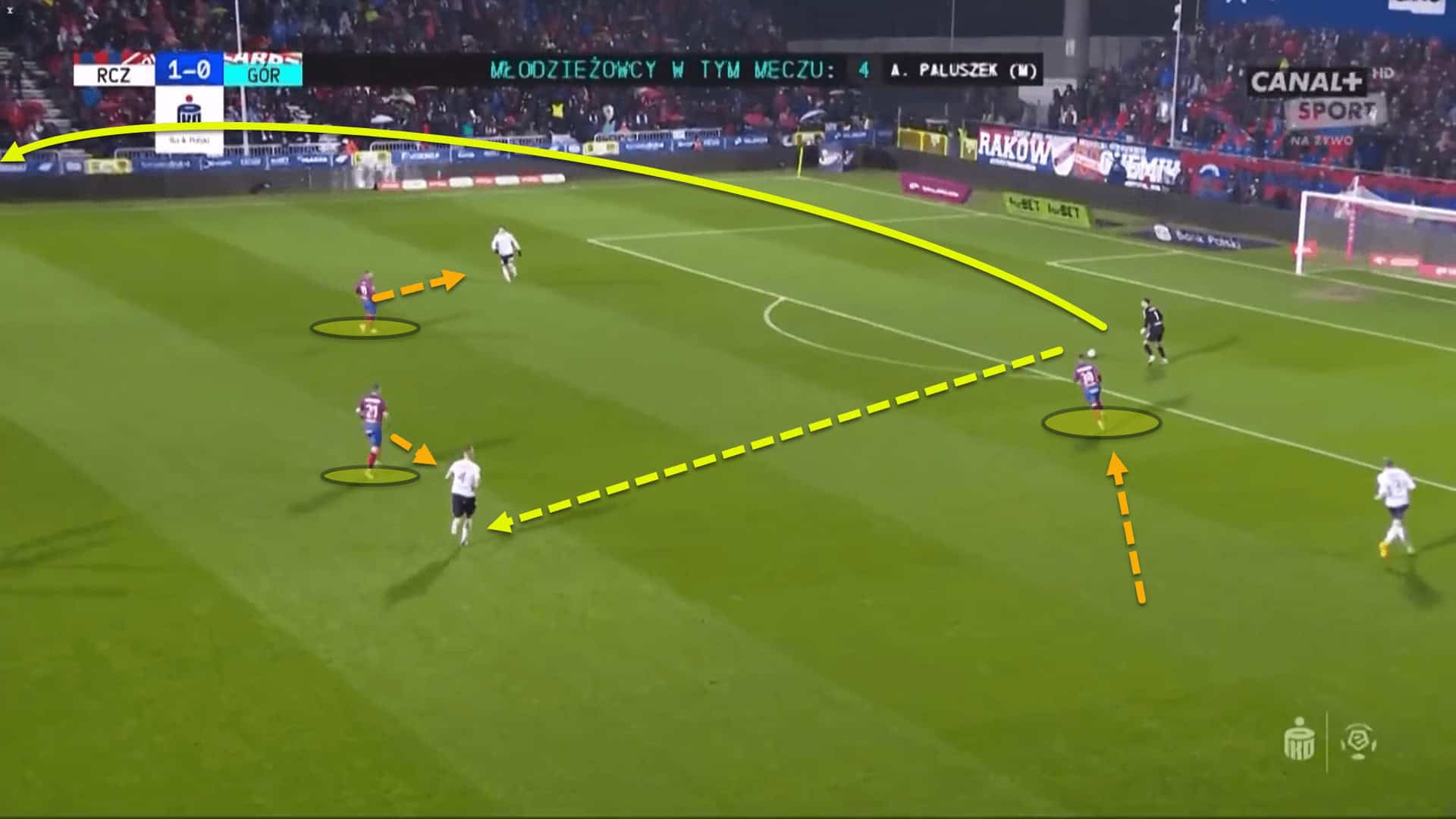
The 48-year-old actually wants his players to angle their pressing to force the attacking side to play into central traps which have been set up by the players’ positioning within their 3-4-3 shape. This is done by having the wingers initiate the pressing rather than the centre-forward.
In the previous image, Vladislavs Gutkovskis, Raków’s main number ‘9’, was sitting on the deepest player in the opposition’s second line which was, coincidentally, the central centre-back.
Meanwhile, the two wingers were pressing the goalkeeper and remaining central defenders in a manner which would force the shot-stopper to either pump it long or try to play down the middle into a marked player. Basically, the shape resembled a 3-4-1-2 at this point but let’s not get bogged down on minute details.
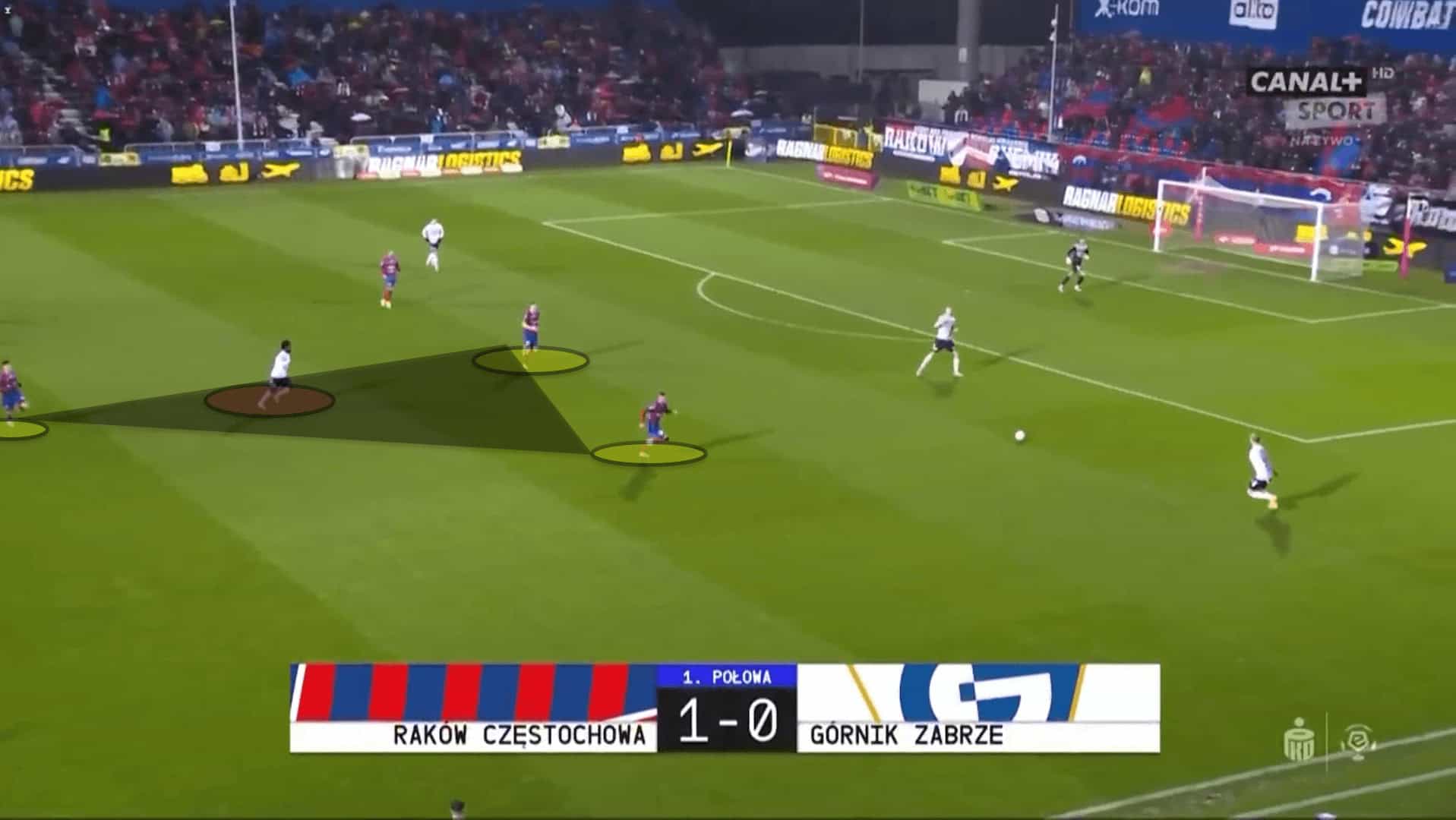
Papszun really wants to entice the team in possession to play the ball into these triangles which are mirrored on either side of the 3-4-3 with the wingers, double-pivot and centre-forward.
Once the ball is moved into these little pockets behind the first line of pressure, Raków can pounce, outnumbering the opponent 3v1, giving them no hope, like a baby gazelle being chased by a pack of starving cheetahs.
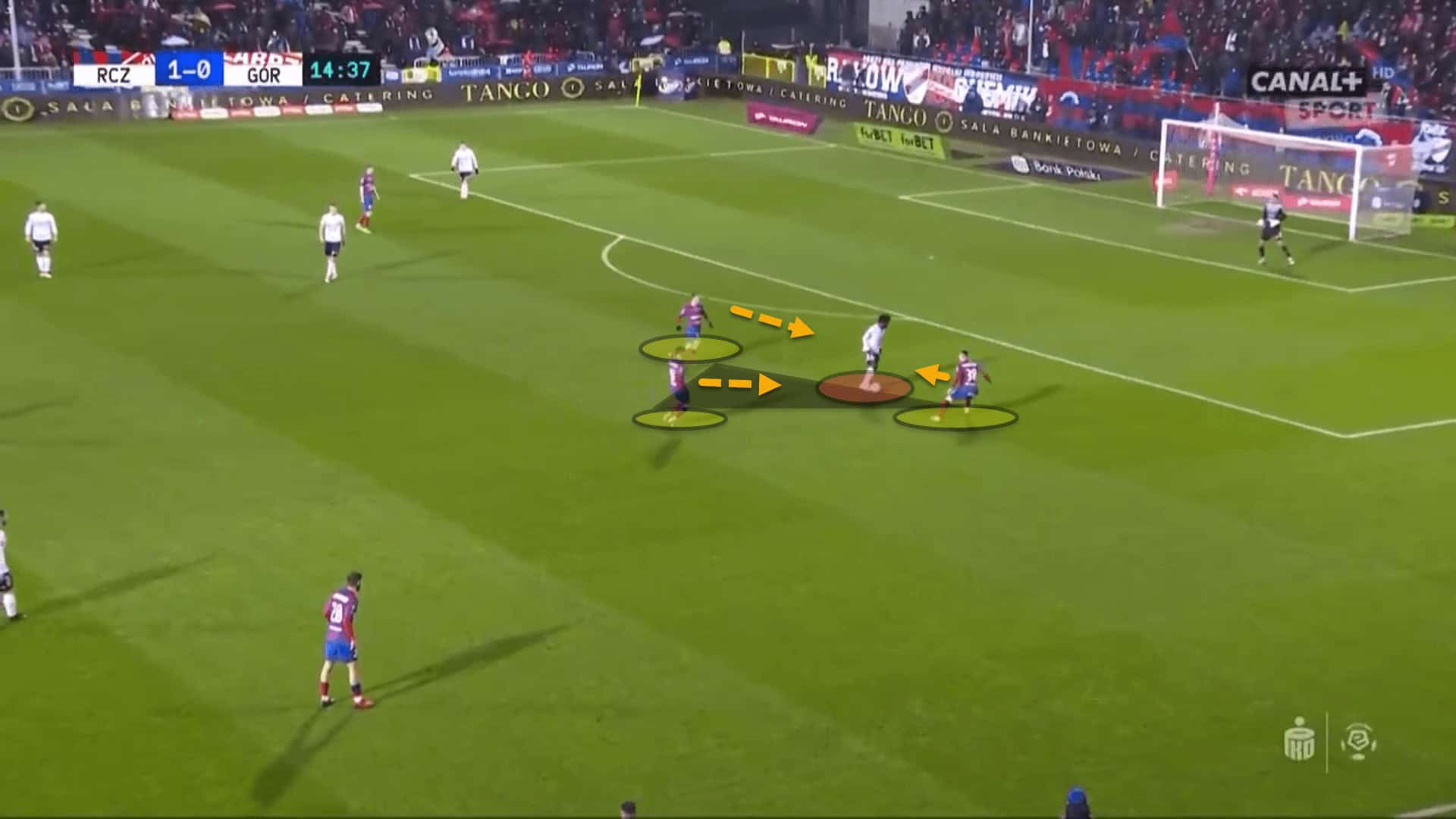
As a result of pressing in this manner, Raków risk leaving the opponent’s wide defenders free to receive the ball in order to act as an option to bypass the pressure. But don’t worry, there’s a solution.
Manchester United press inverted under Erik ten Hag, like Raków, but once the opposition’s fullbacks receive, the English club drop into a deeper defensive block. Instead, Papszun wants his wingbacks to engage their opposite number face-on while the rest of the backline shift across to cover his channel when he is up the flank.
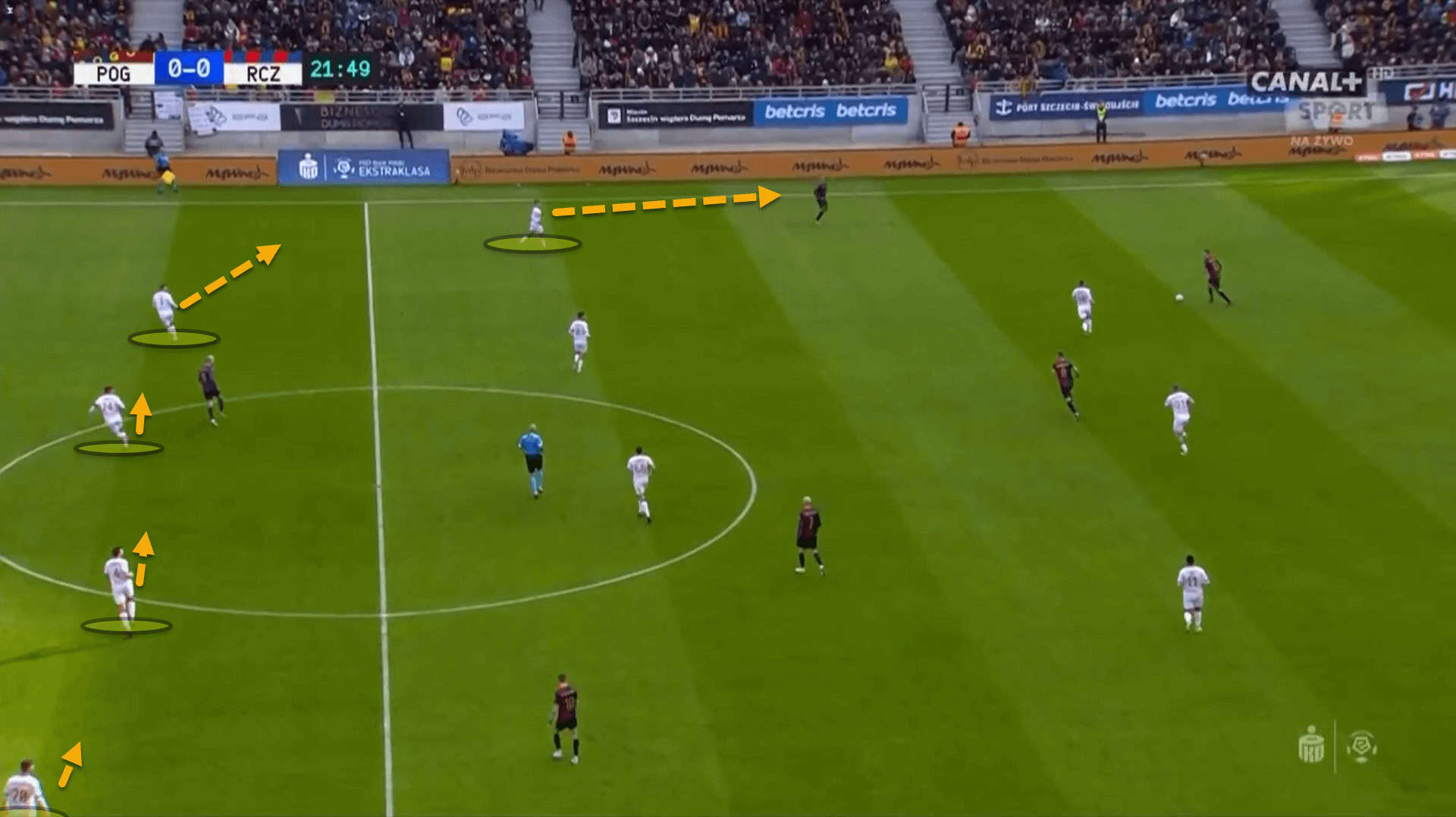
This way, Raków are pressing all over the pitch, trying to keep the opposition as far away from their goal as possible, setting up traps but not shying away from 1v1 duels head-on when the traps are evaded.
And, in fact, it’s this willingness to stop the opponent from progressing the ball forward which has largely contributed to Raków having the best defensive record in the league by far, conceding merely 14 goals in the Ekstraklasa, with the league’s lowest xGA too of 21.86.
Out-in-out patterns and plenty of crosses
It’s pretty interesting that Raków force their opponents inside rather than outside when pressing in the final third to make them uncomfortable but actually move from out to in and then back outside again when they have possession of the ball.
It may seem as though we’ve just used the word ‘out’ a whole bunch of times, and we have, but let’s explain what playing out, in, and then out once more actually entails.
As has been mentioned quite a few times by now, Raków utilise a 3-4-3 formation in and out of possession, although it’s far more fluid when the team have the ball.
The wingers push inside into the halfspaces, and the wingbacks advance forward. The shape practically becomes a 3-2-5.
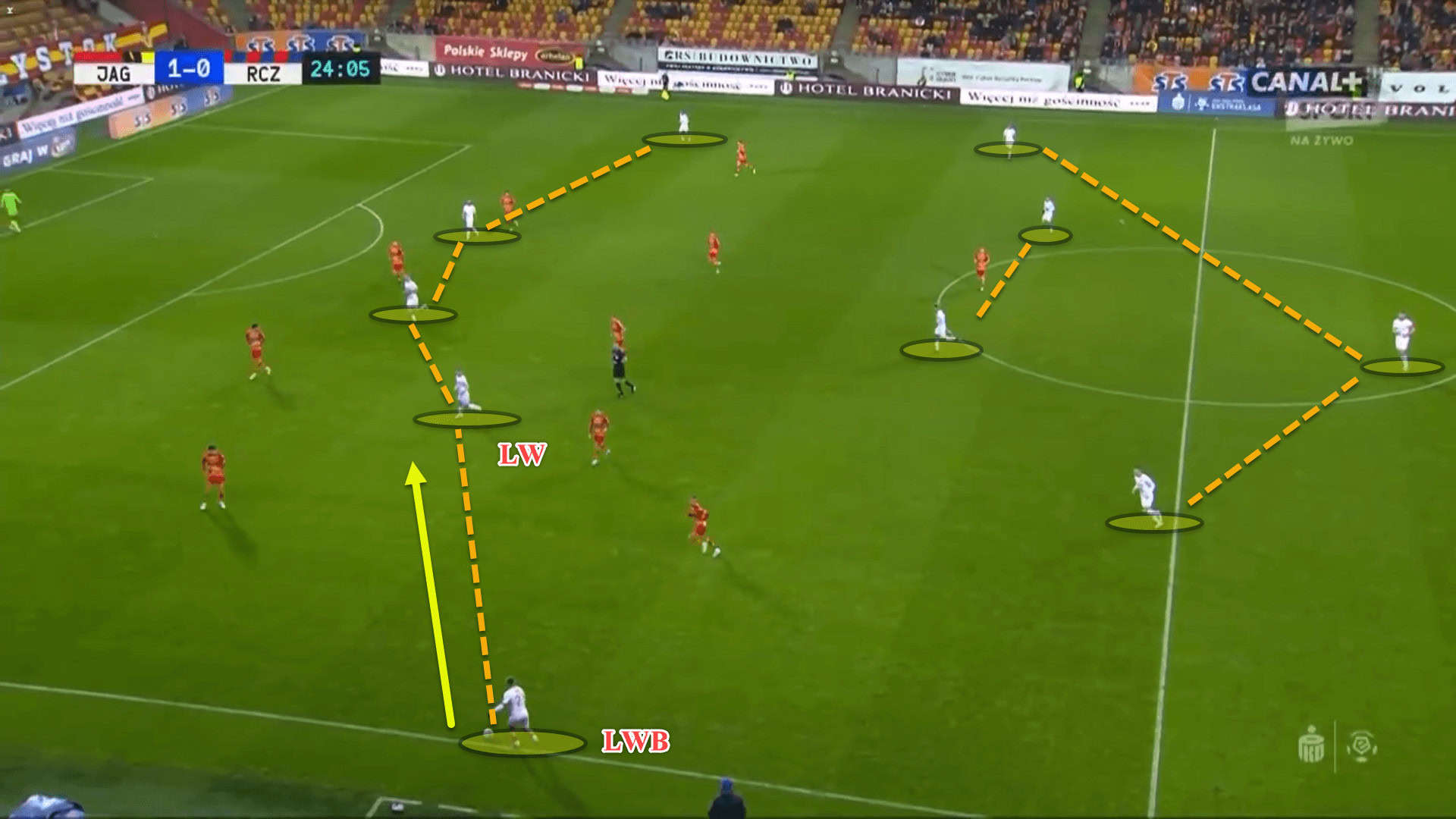
Papszun wants his side to reach the final third by playing out to the wingbacks, inside to the wingers, and then back out to the wingbacks who can then cross the ball into the box.
There is a smart thought process behind this rather particular pattern of play. In the previous image, the wingback received the ball from the defence. In turn, the passing lane opened up into the left-winger in the halfspace.
Once the winger then receives the ball, the opposition narrow their defensive block to close the distance between their players which makes it difficult for the winger to find a player running in behind.
However, it does leave space wide open on the flanks, which is where the wingbacks always are to get a return ball off the winger and cross.
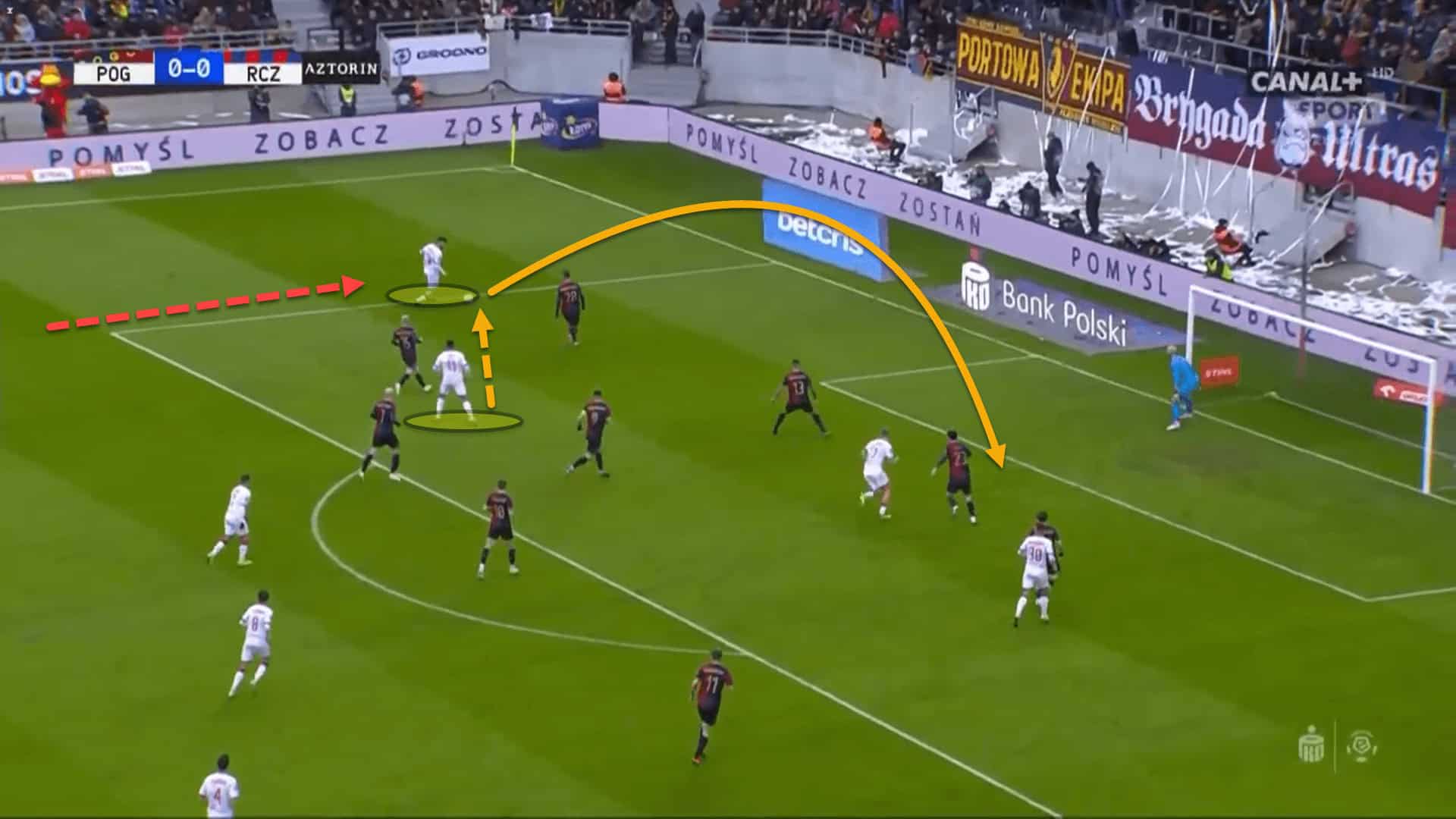
The wingbacks have the space to cross which is why Papszun’s Raków rely so heavily on these two players for chance creation in the final third.
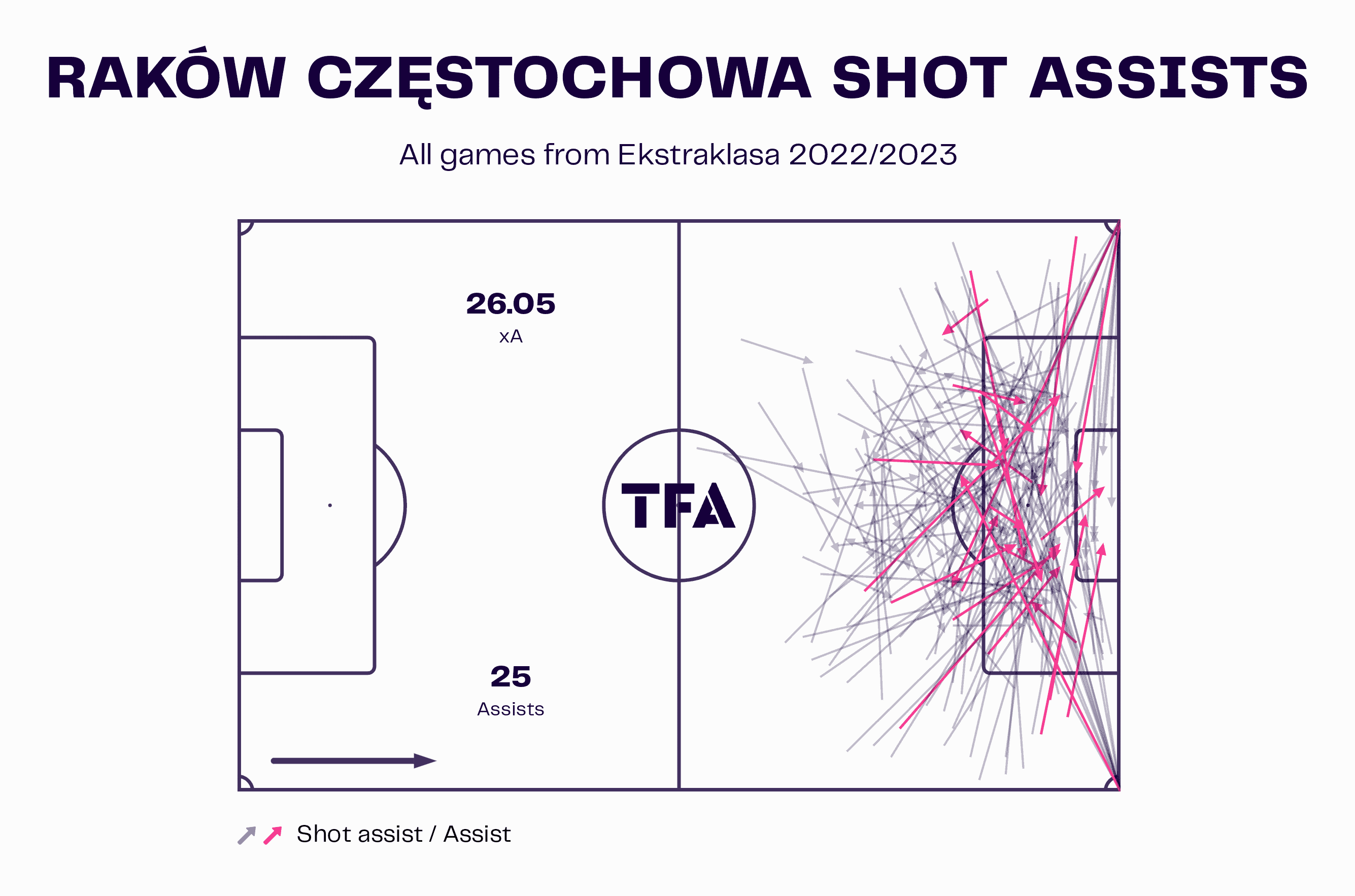
From Raków’s shot assists map, we can see just how many chances and assists come from the wide areas, whether it be from corners or deliveries from open play on the flanks.
Raków like to pack the box with as many players as possible when a ball is going to be whipped into the penalty area but tend to stick to the back-post and overload this space.
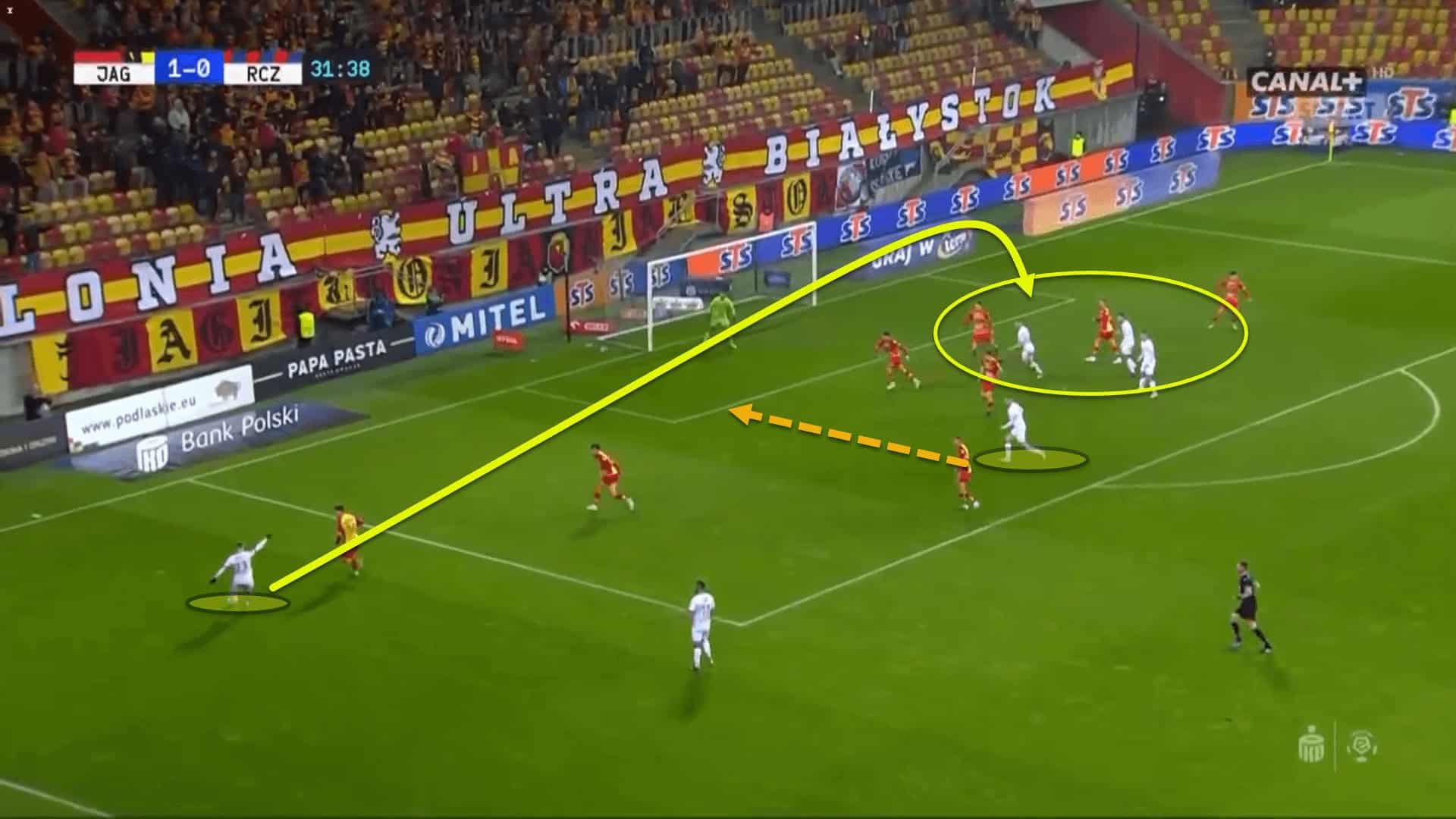
Here, the Medaliki have one player making a run to the near post but three lingering around at the back. This is clearly done intentionally as Raków have a lot of physically large players in the team, particularly in the forward line such as star striker Gutkovskis who stands at around 6 ft 1 and can be a menace in the air.
Activating the wingbacks is not solely placed on the wingers. In fact, the wide centre-backs in Raków’s three-man defence play an important role in possession. The wide centre-backs do not overlap as Chris Wilder’s Sheffield United or Middlesbrough used to but still advance forward very high up the pitch.
They often create wide triangles with the nearest winger and wingback, acting as the base of this triangle.
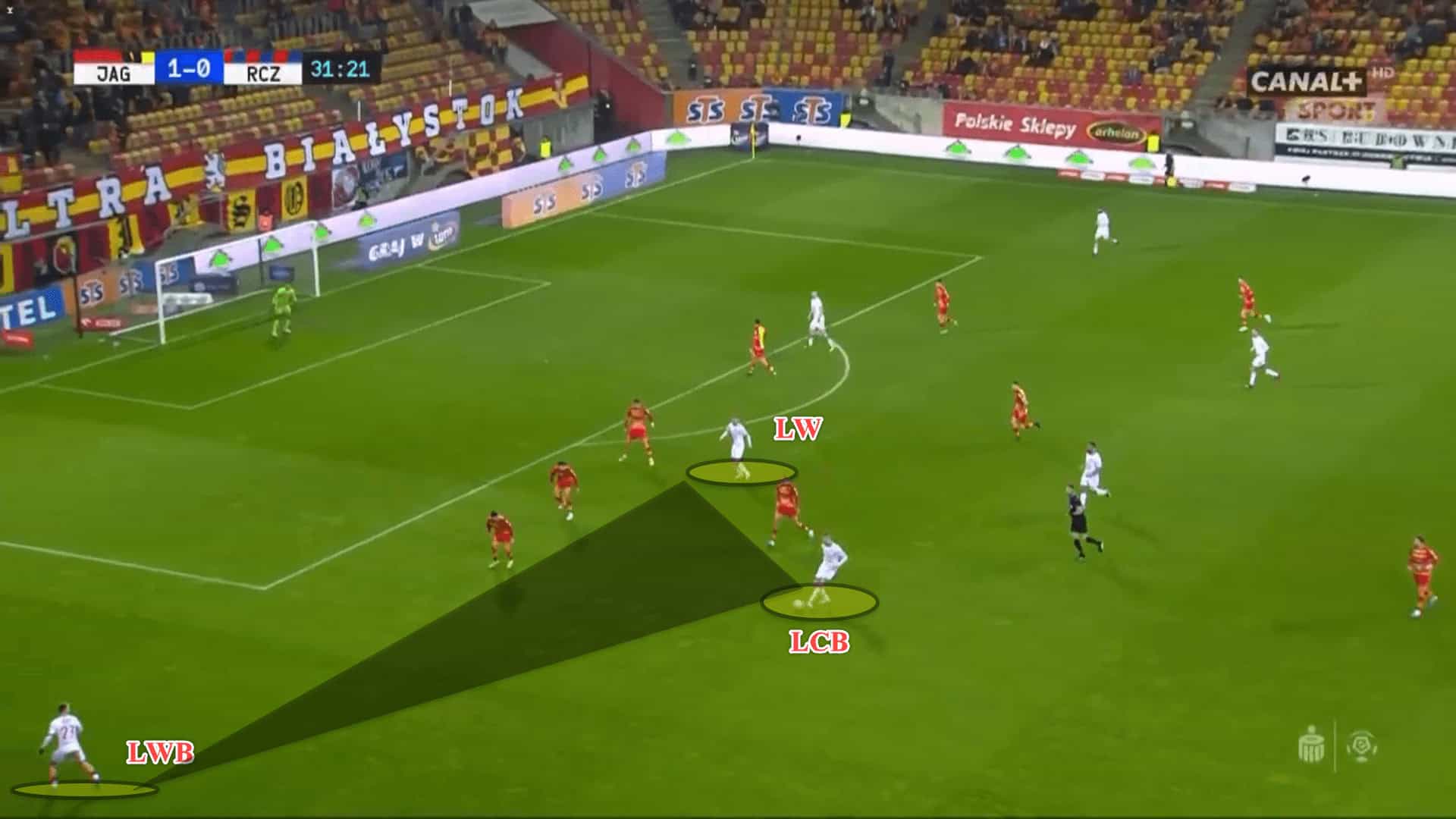
This allows Raków to have an incredibly intense rest defence structure as the wide centre-backs are really high up the pitch, adding an extra body for counterpressing when the ball is turned over, hence why the Ekstraklasa league leaders have registered such a high volume of counterpressing recoveries this season.
But this does lead to problems. Logically speaking, the more bodies you have higher up the pitch, the fewer are back to defend in case the initial counterpress is broken and the opposition are transitioning towards goal.
It’s quite interesting that Raków have the best defence in Poland’s top-flight and one of the best defensive records in Europe but have still been facing regular issues in transition due to their risky nature in possession with the centre-backs.
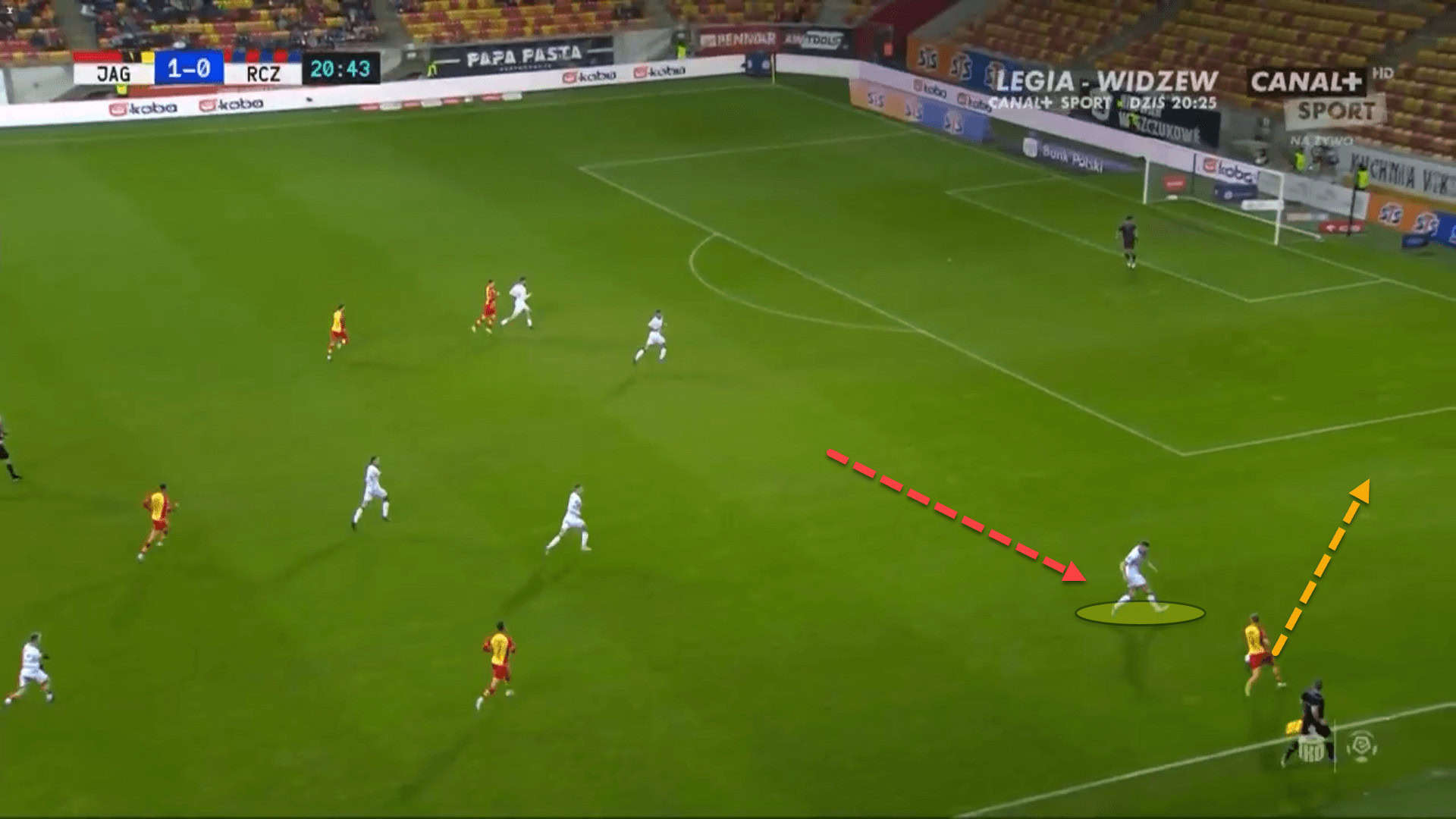
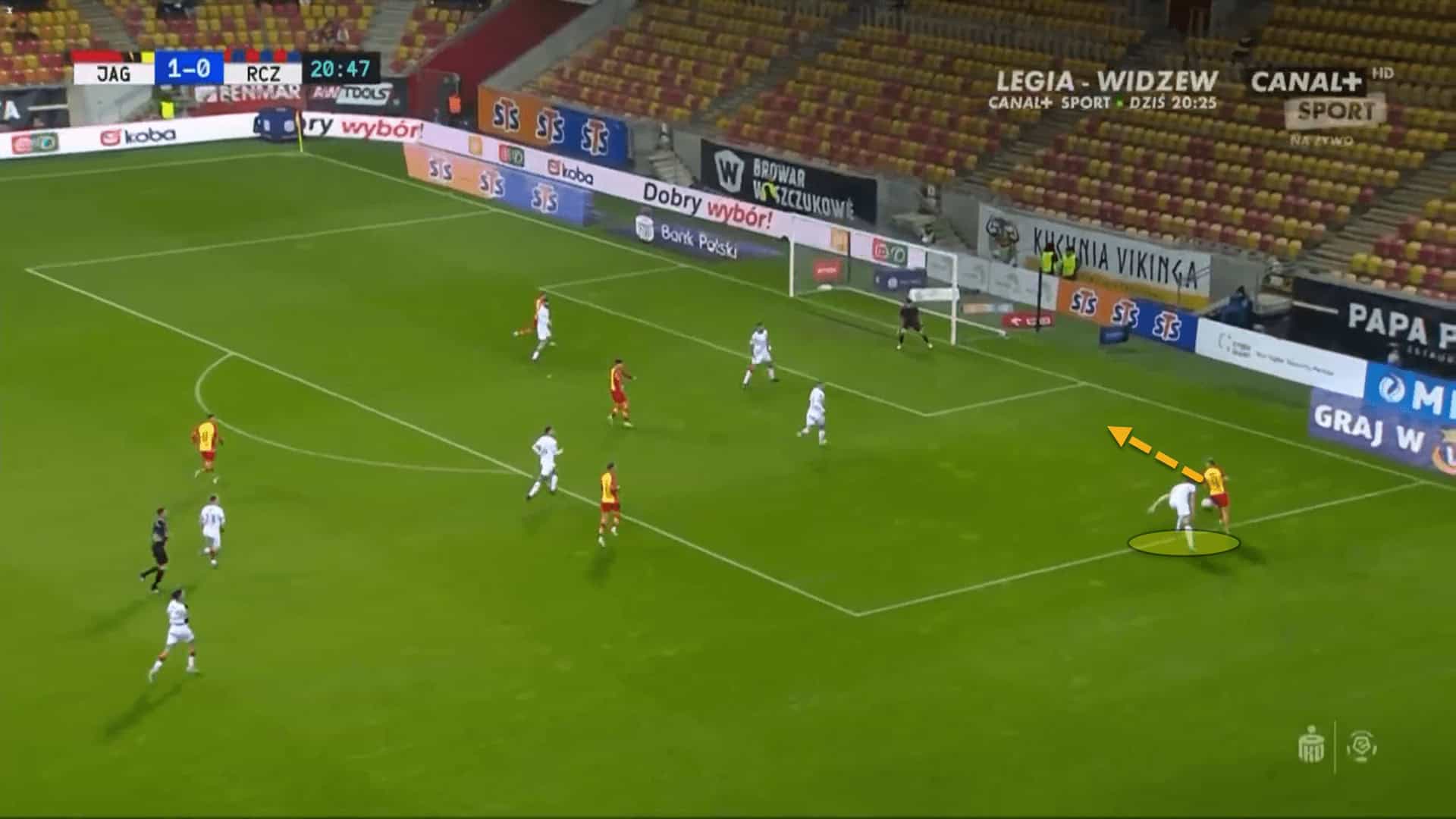
In this example, the central centre-back was forced to come across and cover the flanks but was beaten in a 1v1 duel by the Jagellonia player, almost causing Raków to concede their second goal of the game.
Raków’s defence is so good because they are excellent at keeping their opponents away from the other end of the pitch for long periods of time whether it be through ball retention, constant waves of attack or superb counterpressing, but when they do give up chances, the opportunities are usually of quite a high quality.
Conclusion
The season is certainly not over just yet and so Papszun and co must not get too carried away. However, the supporters can feel something special is happening at the Miejski Stadion Piłkarski as the club is close to reaching a feat for the first time in history under their greatest-ever manager.
Playing an intense style of football that make the Medaliki the most feared team in Polish football right now, no fan would have expected to be in this position at the beginning of the century when Raków were swimming hopelessly around the lower divisions of Poland. Thankfully, as Papszun’s side have proven, anything is possible, and fairytales do happen.






Comments